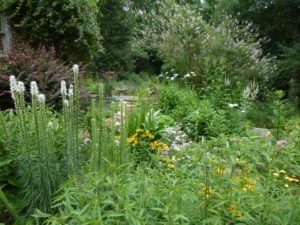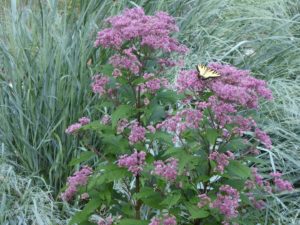
When a section of our small restored forest had to be removed in order to replace the aging septic system, we took this opportunity to begin creating a pollinator garden of mostly native flowers on the now sunny slope. We have continued adding native perennial flowers and shrubs, dedicating it as pollinator sanctuary. The abundance of butterflies, bees, and colorful wasps that immediately began arriving has amazed us and continues to surprise and delight us.
We had no idea how many strange creatures would show up! Day after day some new pollinator comes to join the others, or some new predator on those pollinators, like dragonflies. It’s hot here in the summer sun in North Carolina. I go out for short periods a couple of times a day to check on them, and there’s a new one most every time. What a colorful cast of characters! How did they find us? Where do they come from? They seem to have materialized out of thin air! (Build it and they will come?) Without the flowers to attract them we would never know there are so many different animal life-forms lurking in the vicinity. It would just look green out there and lonely, except for the birds, which are now benefitting from all the new sources of caterpillars to feed their young. I wonder how many other critters have come and gone during the rest of the long summer hours! We imagine that this is just a tiny sliver of the actual biodiversity that exists here that we can help to thrive! It’s a taste of wildness. We may have planted the flowers, but we sure didn’t make the winged creatures come! Amazement becomes wonder, then delight and gratitude for such richness.

The stars of the show for small pollinators are the mountain mints, (Pyncnathemum sp.). Those little inconspicuous flowers have been crowded with a continuous riot, a feeding frenzy, of many different kinds of bees and wasps, maybe twenty different species, numbering in the hundreds daily. Next in preference comes the pink swamp milkweed, full of a myriad of other creatures. The tall white liatris and pink bergamot and red beebalms are next in popularity, these being the scene of much chasing by the hummingbirds and clearwing moths. The tall, graceful Culver’s root, white daisies and purple coneflowers have their devotees, too.
Tiny pollinators seem to prefer the black-eyed Susans, while the huge, purple Joe-pye weeds attract the large swallowtails. Favorite annuals of butterflies and skippers are the non-native zinnias and lantana. In fall there are so many pollinators visiting the white boneset (Eupatorium perfoliatum) I call it “the mountain mint of the fall.”
Here in this pollinator garden we are just beginning to identify some of these important contributors to the web of life. At first I didn’t even know the difference between a butterfly and a skipper! Now I have photographed thirty species of butterflies and skippers in just this one season! To see our photo gallery of these beautiful visitors click here. I still don’t know how to tell some of the bees and flies and wasps apart. But even if I don’t know their names, I am starting to recognize and welcome them as familiar friends. “Hi, shiny black wasp with wide white bands.”
Plants are the only beings who can convert sunlight into energy. These little pollinators drink the nectar and eat the pollen, passing the sun’s energy up the food chain, as they themselves are eaten by predatory insects and by birds. I am fascinated by the intricacies of plant – animal interactions, especially pollination strategies. Paula Gonzalez says, “That members of the ecological community are related to one another in a series of feeding relationships can remind us that we live in a Eucharistic universe.” This is a Christian perspective of this sacred communion. Here is Algonquin tribal wisdom from Evan T. Pritchard: “Exchange is the axis on which the world spins – it keeps Creation going. Every living thing must give and take in order to participate in Creation. Even the earth and sky exchange gifts with one another. All is change, all is exchange. In order to receive, you must give of yourself.”*
Recently our cousin, Lori, on the Lac Courte Oreilles Ojibwe reservation sent pictures of her late mentor, John, making a ceremony in the butterfly sanctuary there, beating on his drum painted with a large monarch butterfly. Now monarchs have joined the tiger and spicebush swallowtails in our pollinator garden, too, especially loving the pink swamp milkweed flowers. We look forward to making a butterfly honoring ceremony for them.
* – Evan T. Pritchard in No Word for Time: The Way of the Algonquin People
Text and photos © Betty Lou Chaika, 2017
Dana
Thank you for sharing this, Betty Love. Can you please share with me where you find native NC seeds and plants to add to your garden? I’m conscious of the fact that many commercial places are not appropriate sources, but I am not sure where to turn to find sources of local/native plants.
Betty Lou Chaika
Hi Dana! Yes, the NC Botanical Garden in Chapel Hill has packets of native seeds and plants for sale through their gift shop. Members get eight free seed packs a year from an even larger selection of seeds. Twice a year, Spring and Fall, there are large plant sales. The next one is coming up soon, May 12, 2-7. Many nurseries that sell native NC plants will have booths there. Excited to hear you are interested in doing some native plantings!